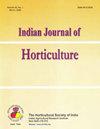辣椒菌核病的生物治理
Q4 Agricultural and Biological Sciences
引用次数: 0
摘要
辣椒菌核腐病是由菌核菌引起的最具破坏性的土传病害之一,严重影响辣椒的成功栽培。本研究对2019- 2020和2020-21季辣椒菌核病的生物治理进行了实地调查。结果表明,各模块均能有效降低该病的发病率。在生物处理模块中,与未处理的对照相比,绿衣霉+荧光假单胞菌10.0 g/kg的种子处理和绿衣霉+荧光假单胞菌2.5kg/ha的土壤施用以及印楝饼5 q/ha的土壤施用+绿衣霉和荧光假单胞菌10 g/l的水淋,每隔10天,从30天开始,每隔2次,最有效地降低了56.2%的发病率,提高了66.7%的果实产量。在株高和叶片数方面,该处理对植物生长的促进作用最大,B:C比值最高,达到2.26。本文章由计算机程序翻译,如有差异,请以英文原文为准。
Biological management of Sclerotium rot of chilli
Sclerotium rot of chilli caused by Sclerotium rolfsii is one of the most devastating soil-borne diseases whichposes a problem for the successful cultivation of the crop. The present field investigation was carried out forthe biological management of Sclerotium rot of chilli during rabi seasons of 2019-20 and 2020-21. It was foundthat all the modules were effective to reduce the incidence of the disease. Among the biological modules, seedtreatment with T. viride + P. fluorescens @ 10.0 g/kg of seed and soil application of T. viride and P. fluorescens @2.5kg/ha and soil application of neem cake @ 5 q/ha + drenching with T. viride and P. fluorescens @10 g/l of watereach twice at 10 days interval starting from 30 DAT was most effective in reducing the incidence of the diseaseby 56.2% and increasing the fruit yield by 66.7% in comparison to untreated control. The treatment also improvedsoil microbial status and achieved the highest plant growth promotion in terms of plant height and leaf numberand maximum B:C ratio of 2.26.
求助全文
通过发布文献求助,成功后即可免费获取论文全文。
去求助
来源期刊

Indian Journal of Horticulture
农林科学-园艺
CiteScore
0.50
自引率
0.00%
发文量
22
审稿时长
4-8 weeks
期刊介绍:
Information not localized
 求助内容:
求助内容: 应助结果提醒方式:
应助结果提醒方式:


